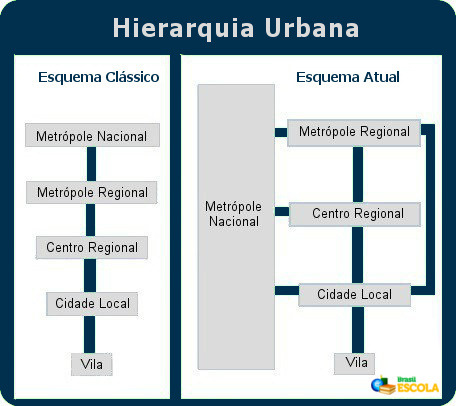THE urban hierarchy it is the way cities organize themselves within a scale of subordination. In practice, it occurs when smaller towns and cities are subordinate to medium cities, and these are subordinate to large cities. Through the urban hierarchy, it is possible to know the importance of a city and its relationship of subordination or influence over others around it.
This theory is not only established by the size of the city or the population contingent, but especially by the quantity and variety of goods and services offered. The greater its importance in the production process, the greater its place in the urban hierarchy.
The idea of urban hierarchy, especially nowadays, is linked to the concept of urban network, which is nothing more than the network of economic, social and cultural relations that make up cities.

The process of globalization and the improvement of transport and communications have changed the urban hierarchy.
New urban hierarchy
The classic scheme of the urban hierarchy has undergone important changes over the last few decades. The reason is the history of cities and the evolution of the media and
transport, which are results of the process of globalization. The subordination process no longer follows a continuous scale. In many situations, the inhabitants of smaller cities go directly to urban centers such as regional or national metropolises to acquire goods or services.Do not stop now... There's more after the advertising ;)
This new reality is the result of the flexibilization and popularization of the means of transport, which allow the people choose where they want to buy products, not being subordinate to the nearest urban center.
The urban hierarchy is composed of structures categorized in the following classification:
-
Metropolis: a larger city that is characterized by the power of attraction and influence it exerts on a significant number of cities in its surroundings. It is the most important center of the urban network, so its level of influence can be classified as regional or national:
national metropolisAttractions: Large urban center, with a variety of services and influence on regional centers, regional capitals and regional metropolises.
regional metropolis: City that exerts great influence in its own state. It has more than a million inhabitants and a large concentration of people.
Regional centers: They are medium-sized cities that exert influence at a regional level. They may or may not be a state capital. They are usually a reference in the development of the production of goods and services for the cities in their surroundings and also establish a closer link with the national metropolises;
Local city: a small city in which its population often resorts to larger urban centers to have access to goods or services that are not offered there;
Village: small urban agglomeration that has not reached the status of a city. The vast majority of goods and services are not offered. It needs to frequently resort to larger urban centers to have its needs met.
By Amarolina Ribeiro
Graduated in Geography
Would you like to reference this text in a school or academic work? Look:
RIBEIRO, Amarolina. "What is urban hierarchy?"; Brazil School. Available in: https://brasilescola.uol.com.br/o-que-e/geografia/o-que-e-hierarquia-urbana.htm. Accessed on June 28, 2021.

